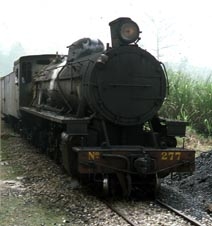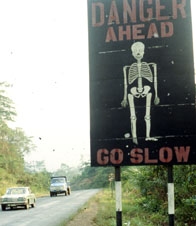To reconstruct Kwawu history it is necessary
to look at archaeological data, oral traditions, archival reports of missionaries
and colonial administrators, then gazettes and newspapers. Integrating
and reconciling these disparate sources is an interesting but sometimes
difficult challenge
The Afram; Once a large savannah plain between the Afram and the Volta rivers, the Afram is now mainly part of the lake formed by the Akosombo dam. Prior to the building of the railway between Accra and Kumasi, the Afram river by canoe was the major transport medium between Kumasi, Kumawu Kwawu and the coast. Before the arrival and expansion of the Akan, the Afram Plains was the location of a major Guan kingdom headed by Ataara Fidam (the same name being given to a series of kings). Settlement Patterns. The spatial relationships between settlements and land reflected the historical migration and development. Earlier populations lived in dispersed settlement farming the land close to where they lived. The Guan brought with the nucleated settlements where several related patrilineages lived in a larger village and the people farmed around that nucleus. The matrilineal Akan brought with them federations of lineages who lived in settlements more highly organised for defences and war (so as to control trade routes) and each matrilineage eventually developed a pie shaped piece of land with the confederation setting up its ancestral stool houses in the central core. Round to Square; The earliest residences, apart from the caves, were built of branches and leaves and were generally round with the roof merely being the walls tied together at the top. Hunters still build a few of these houses today when away on a long hunt. The Guan brought with the the use of clay, either wattle and daub for houses quicker to build but less permanent, or sun baked clay bricks for more permanent houses. Since the Akan retained the Gods of the Guan, many old houses of Gods are still round. The Akan, who can be traced to the Sahara and even to Egypt, brought with them an architecture more suited to the desert, square but with a central square courtyard. The shift from round to square, therefore, coincides with the social and political change from patriliny to matriliny. Swiss Missionaries. When Ramseyer, a Swiss Pietist from Basel, tried to found his "Ashantee Mission," he was abducted and spent three years in captivity. When freed, he was not allowed into Asante, so he built his mission in Kwawu. Kwawu used the event to declare independence from Asante by murdering the Asante ambassador. The Bretuo and Tena clans (Twidan) in Abetifi and Abene were pro European and led the movement towards becoming a British Protectorate. The Asona and Dwumina clans of the Benkum division were allied to those of Kyibi which was already part of the Gold Coast Colony. Obo led the pro Asante faction in Kwawu, as head of the Nifa division, being of the Amoakade and Ada (Aduana) clans and relatives of the leaders of Kumawu. Until Britain made Kwawu a protectorate, this was technically a time of Kwawu independence –– the only time. Kwawu became, in effect, a colony of the Swiss missionaries, who organized road building, a post office service, and so much more. After Asante was finally defeated in 1901, and Kwawu became part fo the colony, the second generation of British administrators (not wealthy aristocratic dilettantes like the first generation), became jealous of the Swiss and cooked up a conspiracy to remove them. They accused the Swiss of being German sympathizers and spies during the World War (false), put the men in concentration camps, sent the women to Britain, and handed over the congregation to the Presbyterian Church of Scotland, keeping all the public services to themselves. Unfortunately, this chapter of Kwawu history is not yet written, and all I have to show here are four archival photos from the 1880s taken by the Basel missionaries. Trains; Perhaps the most revolutionary modern technological introduction was the railway, in the first half of the twentieth century. It was built on the South side of the Kwawu escarpment and took away the Afram river as the main route between Kumasi and the Coast. In spite of the historical importance of the train, it was allowed to deteriorate, a road replaced it for transport, and it became defunct during the 1970s. A complete history of Kwawu, using all the sources mentioned above, is part of the 500 page PhD dissertation for the University of Ghana, Legon. Lack of resources prohibits me from typing this into computer files to make it available on the Internet.
|
 .
.




